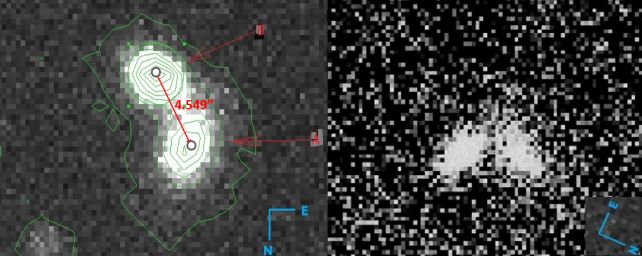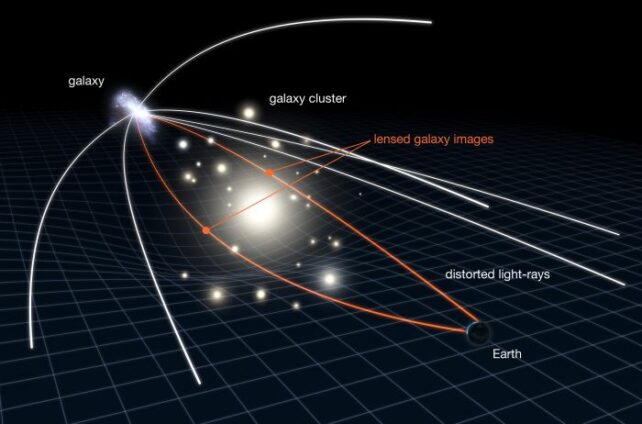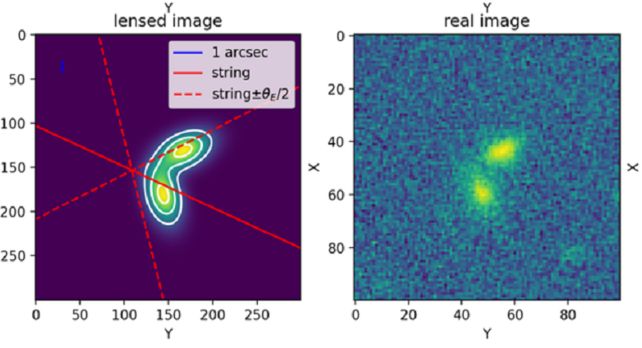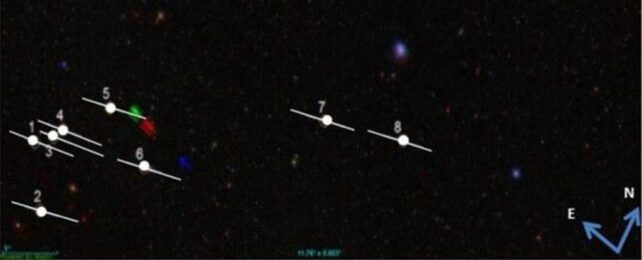A strange pair of galaxies several billion light-years away could be evidence of a hypothetical 'crease' in the Universe's fabric known as a cosmic string.
According to an analysis of the properties of the pair, the two galaxies may not be distinct objects, but a duplicate image caused by a trick of the light. And the reason the light is duplicated could be because of a scar in the space between us and the galaxy, creating a gravitational lens.
A paper describing this cosmic string candidate, led by Margarita Safonova of the Indian Institute of Astrophysics, has been accepted in the Bulletin de la Société Royale des Sciences de Liège, and is available on preprint server arXiv.
Cosmic strings are like tiny, one-dimensional wrinkles or cracks through the fields of the Universe, thought to have been created at the very dawn of time as reality stretched and then froze into place.

These theoretical topological defects are estimated to be no wider than a proton, may extend the entire breadth of the Universe, and are thought to be incredibly dense and massive. Theory suggests that they may very well be real, but we haven't seen much physical evidence of them.
Cosmic strings are not easy to prove observationally. That's because the effects they have on the Universe can look a lot like ef fects that have other explanations. But there can be minute differences that point more to cosmic strings than those other explanations.
Safonova and her colleagues have identified not just one, but several, in a cosmic string candidate named CSc-1, identified in the cosmic microwave background, the leftover radiation from the birth of the Universe. However, they focused their paper on the strongest cosmic string signature, a galaxy pair named SDSSJ110429.61+233150.3, or SDSSJ110429 for short.
SDSSJ110429 could just be a normal pair of galaxies. Another explanation when we see galaxies very close together, and looking similar, is that they are duplicate images, produced by a gravitational lens.

This is when space-time curves around foreground mass, like the curvature induced by a weight on a trampoline. Light traveling from a more distant object through that space-time follows a curved path, resulting in observable distortions, magnifications, and duplications.
Usually, we can see the foreground mass that is creating the lensing effect, such as a galaxy or a cluster of galaxies. And the light of the background object is usually distorted, and there's a time delay between duplicate images. The absence of these properties could mean that we are looking at two galaxies, not a single lensed galaxy. Or it could suggest the presence of cosmic strings.
There doesn't appear to be an obvious foreground mass in front of SDSSJ110429. Nor is the light distorted. But Safonova and her colleagues from India and Russia conducted a detailed analysis of the light from both galaxies. Both had almost identical spectra; that is, the light coming from each galaxy was neatly twinned in the other.
They are also more or less the same size, the same distance, and the same shape, mirrored as you would expect to see in a gravitational lens duplication. And other galaxy pairs within the CSc-1 field showed similar properties.

Most cosmic string models are based on straight strings. Safonova and her team calculated that the observed CSc-1 galaxy pairings could be duplicated by changing the orientation and possibly the bend of the string.
"Our modeling of observational data in CSc-1 shows that a large number of pairs can be explained by the complex geometry of the string," the researchers write.
"Considering a model of a cosmic string with the bend in the image plane can improve the search for GL event candidates. In particular, modeling of the SDSSJ110429-A,B galaxy pair has shown that the observed angle between the components of the pair can be explained if the string is strongly inclined to the line of sight and, possibly, bent in the image plane."
It's not a smoking gun. Detection of a cosmic string is going to require extraordinary evidence. But it does open up a new avenue for seeking these elusive objects.
The research has been accepted into the Bulletin de la Société Royale des Sciences de Liège, and is available on arXiv.
